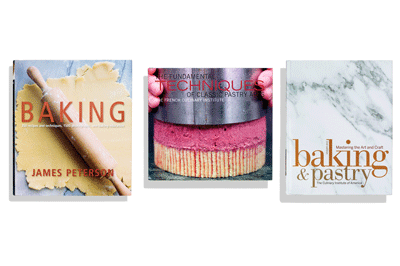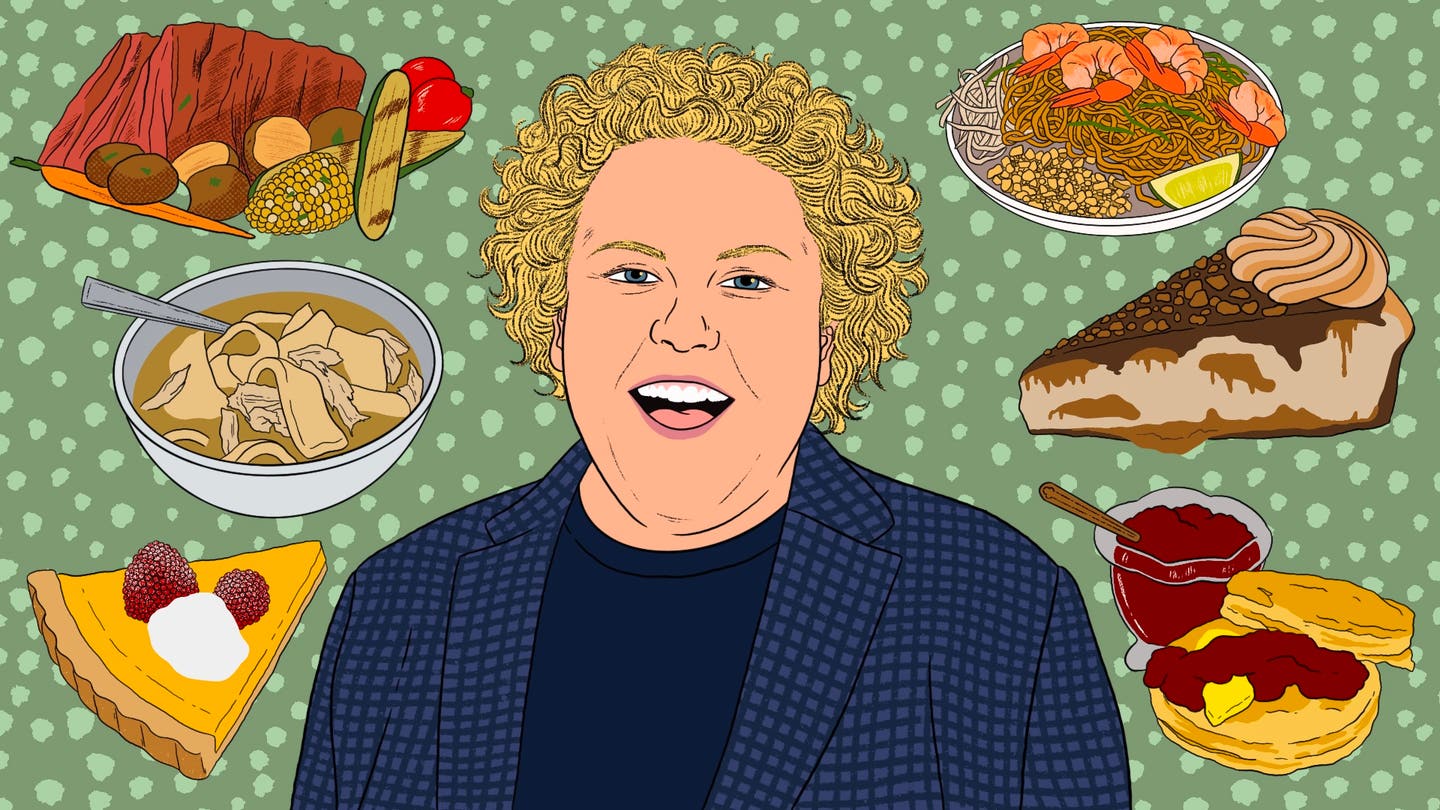
Taking the Cake
Few memories are as precious to me as that of my first lick of sour cream cheesecake batter from my mom's spoon when I was four years old. I loved the taste so much that Mom made that cake for my birthday every year after that, until I left our Mississippi home for college and, later, culinary school. That's how my lifelong passion for baking was born: at my mother's heels, with me constantly peering over her shoulder to see how she concocted her pecan pie, her light-as-air cheese straws, her crumbly vanilla tea cakes.
But here's a confession, Mom: you may have ignited the spark, but cookbooks have kept the flame burning. Poring over and studying baking books—scores and scores of them through the years—has inducted me into the wider world of baking beyond my Southern sphere of knowledge and inspired my fascination with the science behind the craft. I've compiled a large library, including a few reliable favorites I find myself turning to repeatedly. However unfortunate the title is for me, Nigella Lawson's How to Be a Domestic Goddess (Hyperion, 2001) is a tried-and-true companion; the same goes for Sherry Yard's The Secrets of Baking (Houghton Mifflin, 2003), which provides simple recipes and tells you how to customize them to your tastes, setting you free to improvise. And I never fail to learn something new from Regan Daley's comprehensive In the Sweet Kitchen (Artisan, 2001).
This year has been an especially good one for my baking library, to which I've added half a dozen or so first-rate newly published volumes. For an all-purpose, nuts-and-bolts baking book, it doesn't get better than Fundamental Techniques of Classic Pastry Arts (Stewart, Tabori & Chang, $75), a 500-page tome of recipes and techniques compiled by the French Culinary Institute, the cooking school in New York City (full disclosure: I'm an alum). The FCI is famous for its professional bakery program, which the celebrated pastry chef and chocolatier Jacques Torres helped design, and the book does a great job of putting the curriculum into print. In-depth chapters on equipment and ingredients explain how each piece of the pastry puzzle—from the importance of salt to how pastry is leavened—affects the outcome. The book takes a time-honored pedagogical approach, starting cooks off with beginner recipes, like ones for pastry cream and profiteroles, and encouraging them to build on earlier lessons to tackle technically demanding creations like the gateau St-Honore, a formidable cream puff cake filled with whipped cream and crowned with spun sugar.
Another wide-ranging, all-purpose gem is James Peterson's Baking (Ten Speed Press, $40). An instructor at New York's Institute of Culinary Education, Peterson has written and photographed several step-by-step technique books, and his latest is a "greatest hits" of the pastry world, walking readers through everything from simple custards and cookies to elaborate gateaux and rustic breads.
Lest my mom think my formal education has caused me to stray too far from my roots, I must add that I'm still in love with homey desserts like the ones in Karen DeMasco's The Craft of Baking (Clarkson Potter, $35). DeMasco was the longtime pastry chef at Tom Colicchio's acclaimed New York City restaurant Craft, and in her book she shows beginning bakers how to reproduce with ease the delicious, comforting desserts for which she was known there: butterscotch pudding, Key lime meringue pie, chocolate cake doughnuts, and more.
By my lights, though, when it comes to finding deep satisfaction for the sweet tooth, nothing beats cake. Rose's Heavenly Cakes by Rose Levy Beranbaum (William Morrow, $39.95) is a trove of show-stopping recipes that constitutes a command performance after Beranbaum's hugely popular book The Cake Bible (William Morrow, 1988). Among the hundred or so choices, I found an easy and luscious red fruit shortcake, a devil's food cake that I now consider the gold standard, and a riff on American Gingerbread Cake that acquires impressive moistness and tanginess from British golden syrup and orange marmalade.
My love of dessert aside, I'm as interested in yeast as I am in sugar, and I've been contentedly baking my way through several remarkable bread books lately. Artisan Breads Every Day by Peter Reinhart (Ten Speed Press, $30), the renowned cookbook author and baking instructor at Johnson & Wales University, in Charlotte, North Carolina, demystifies the complexities of bread making by offering ways around laborious traditional methods. For example, instead of instructing readers to start with a time-consuming pre-fermentation of flour, yeast, and cold water, Reinhart suggests simply adding warm water to the yeast before mixing the dough, which saves time and yields fine flavor. I wish I'd had a book like this when I started baking bread; Reinhart's friendly recipes instill confidence, whether you're making his herb oil focaccia, cinnamon raisin bagels, or sumptuous braided challah.
One of the recent baking books I admire places the seemingly straightforward act of baking bread in a broader context. The British baking author Andrew Whitley—a cofounder of the London-based Real Bread Campaign, an organization that advocates for additive-free, natural breads—shows an almost political fervor in Bread Matters (Andrews McMeel, $34.99). Whitley advances his organization's mission by offering alternatives to baking with commercial yeasts and white flour and also includes lots of excellent gluten-free recipes calling for non-wheat flours. Skeptical at first, I ended up being surprised at how much I loved the breads I made from this book. Whitley's version of Russian Borodinsky bread—made with rye flour and molasses—had lovely, caramelized notes. And his potato and quinoa bread, made with brown rice flour and chestnut flour, had a pleasingly nutty, earthy perfume.
I don't come across many baking books that I'd characterize as revolutionary, but Jim Lahey's My Bread (W. W. Norton, $29.95) is just that. The founder of New York City's Sullivan Street Bakery, Lahey gained a following in 2006 when the New York Times published his groundbreaking "no knead" bread recipe—an easy technique that reduced both the precision and the amount of elbow grease required for making good, crusty bread. This book is devoted to that technique, with dozens of recipes that call for it.
True, when I made Lahey's basic boule—which requires nothing more than stirring together flour, salt, yeast, and water, letting the mixture ferment for a very long time (18 hours, in this case), and baking it in a Dutch oven—I found myself longing for the tactile pleasure of kneading I'd become accustomed to. Then I tasted my work; the loaf was tangy and earthy, with a moist, chewy crumb and the crispest crust I'd ever achieved in all my days of baking. Other recipes, from -olive-studded loaves to onion-topped pizzas, build on the no-knead method and produce equally tasty results. My Bread is a soulful and generous book, enriched by Lahey's own reflections on the breads, bakers, and ovens he's known. Baking is his craft, his life. I guess I can relate to that.
Keep Reading
Continue to Next Story










